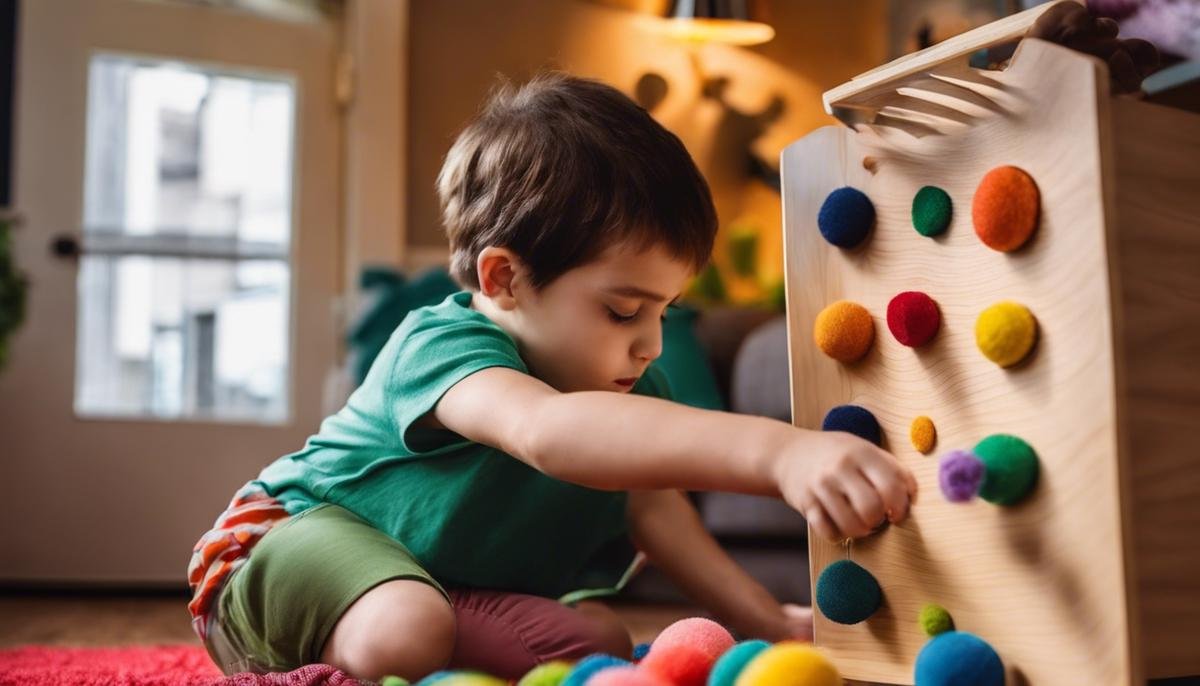
The journey through understanding autism spectrum disorder (ASD) unfolds a complex tapestry of behaviors and characteristics that uniquely shape the way individuals with ASD interact with the world. At the heart of raising awareness and enhancing the quality of life for those on the spectrum is a keen focus on identifying and managing potential safety risks that autism may inherently present. From the nuanced ways in which sensory sensitivities can alter perception to the challenges of non-verbal communication and the unpredictable impulse to wander, grasping these elements is crucial for cultivating a secure environment. As we embark on a detailed exploration of safety management in the context of autism, we illuminate not only the challenges but also the powerful strategies and tools at our disposal to ensure both protection and empowerment for individuals with autism.
Understanding Autism and Associated Risks
Navigating the Risks: Understanding Autism in Our Kiddos
Hey there, fellow parents!
When it comes to autism, there’s a vibrant spectrum of experiences and abilities that our little ones may encounter. It’s a journey that’s both uniquely challenging and deeply rewarding. But along the path of raising kids on the autism spectrum, there are some common risks we all need to be aware of, to keep our kiddos safe and help them thrive.
First and foremost, let’s chat about safety concerns. Kiddos with autism might have a bit of a daredevil streak when it comes to wandering or bolting, which, I’ll tell you, can be pretty nerve-wracking. So, childproofing homes, teaching safety skills, and maybe even considering GPS tracking devices can be game-changers for peace of mind.
Now, onto social and emotional challenges. Our sweeties might struggle with making friends or reading social cues, which isn’t easy for their little hearts (or ours). It’s so important to nurture their self-esteem and facilitate social opportunities in environments where they feel comfortable and accepted.
Let’s not forget about communication barriers. Some kiddos might be chatty in their unique way, while others may not use words to express themselves. It’s all about embracing their style of communication and providing them with the tools and support, like speech therapy or communication devices, they need to express those big feelings and brilliant ideas.
Healthwise, there’s a risk that our youngsters might have co-occurring conditions, such as gastrointestinal issues, sleep disturbances, or epilepsy. Regular check-ups and tuning in to their needs is crucial. Being proactive with healthcare providers who get the whole picture of autism can make all the difference in managing these conditions alongside autism.
The learning curve can be steep, but we wouldn’t trade our roles for anything in the world. Educating ourselves about the risks associated with autism is one of the many ways we show our boundless love and commitment to our incredible kiddos. Together, we’ll continue to celebrate their triumphs, support them through challenges, and look forward to all the joyous milestones ahead.
Warm hugs and high-fives to all the amazing parents out there – keep nurturing those unique and wonderful little individuals in your life!

Creating a Safe Home Environment
Designing a Haven: Autism-proofing Your Home for Safety and Comfort
As families navigate the journey of raising children with autism, creating a home that is both safe and nurturing becomes a paramount concern. The nuances of parenting a child on the spectrum often require additional layers of preparation and awareness, tailored specifically to meet the unique abilities and challenges presented by autism.
Safeguarding against accidents while fostering an environment that supports your child’s growth and happiness is possible through thoughtful home adjustments. Here are some practical ways to autism-proof your home, ensuring it’s a secure and supportive space where your family can thrive together.
Establish Clear Boundaries and Zones:
Within your home, it is beneficial to delineate spaces with specific purposes. By having clear divisions between play areas, quiet zones, and spaces for daily routines like eating or bathing, you help to provide a structured environment that can reduce anxiety and help manage expectations.
Securing Potential Hazards:
Furniture and appliances should be anchored securely to prevent toppling, and locks added to cupboards with chemicals or dangerous items. Corners on tables and other sharp edges can be covered with padding to prevent injury. Doors and windows may also need special attention with alarms or safety locks to prevent wandering, a common concern among children with autism.
Sensory-Friendly Spaces:
Many children with autism possess heightened sensory sensitivities. Consider creating areas in the home that cater to your child’s sensory needs. This could include a quiet corner with soft lighting and texture-rich items or a sensory play area filled with materials that engage your child’s sense of touch, sight, and sound in a soothing manner.
Simple Navigation:
Keep the home clutter-free and predictable to navigate. Too many decorations or furniture pieces can be overwhelming and disorienting. Clear pathways and consistent placement of furniture helps in fostering independence and comfort in moving around their own home.
Lighting and Acoustics:
Pay special attention to the lighting and acoustics of your home. Fluorescent lights, for example, can sometimes flicker at a frequency that is disturbing to someone with autism. Opt for natural lighting or LED lights that are dimmable. Additionally, minimizing echo and controlling the volume of the home environment can help prevent sensory overload.
Embrace Technology for Security:
Home technology such as cameras, smart locks, and motion sensors can be immensely helpful in keeping your child safe. They can alert you to your child’s movements and allow you to monitor their wellbeing without being intrusive.
Secure Outdoor Spaces:
If you have outdoor spaces, ensure they are safely enclosed with visible borders such as fences, and lock any gates. Gardens can pose risks with certain plants, so opt for non-toxic species and remove any sharp gardening tools from easy-to-reach places.
Empathy in Design:
Above all, one of the most important aspects of autism-proofing your home is to come from a place of empathy and understanding. Treating the home as a haven for your child means considering their perspective, fears, comforts, and needs in every adjustment you make. It’s not just about the physical space; it’s about creating an atmosphere that says ‘You are safe, loved, and understood here.’
In implementing these measures, you’re paving the way for a home that not just safeguards, but also empowers your child on the autism spectrum. Each child is different, so adapt these recommendations to meet the unique needs of your child and family. With each step, you’re not just autism-proofing a house; you’re crafting a nurturing sanctuary that supports everyone’s well-being.

Strategies for Public Safety and Awareness
Heading out into the world with autistic children can often bring a mix of emotions. Feelings of pride and excitement can intermingle with a sense of apprehension regarding their safety in public spaces. As family units venture beyond the comfort of their childproofed homes, having strategies to ensure safety becomes essential.
One key approach is establishing a detailed plan before a day out. This includes choosing destinations that are known to be accommodating to sensory needs, being familiar with the layout, and having a clear schedule to reduce unpredictability which can sometimes cause distress for autistic children. Ensuring the child knows this plan, as much as they are able to understand, is equally important.
Identification aids, such as bracelets with contact information or discrete labels on clothing, can be a tangible safety measure. These are especially crucial in the event a child becomes separated from their family, as they may have difficulties communicating personal details to strangers or authorities.
Another practical tip is harnessing the power of technology. There are various location-sharing apps and devices that allow parents to keep track of their child’s whereabouts. Some of these tools offer geofencing features, which alert parents if their child goes beyond a predetermined safe zone, providing an additional layer of security.
During outings, keeping familiar items on hand can provide comfort and a sense of security for autistic children. These items can be anything from a favorite toy to a particular piece of clothing which can act as a grounding tool in stimulating environments.
Behavioral strategies like modeling and role-playing different scenarios at home can also bolster safety. These practices can prepare children for interactions in public, such as what to do when approached by a stranger or how to seek help when lost.
For older children and those capable of understanding, engaging in discussions about safety rules, personal boundaries, and the concept of ‘stranger danger’ can empower them to make safer choices when navigating public spaces. However, it is crucial to balance these conversations to not instill undue fear but promote awareness.
Lastly, never underestimate the support of the community. Connecting with other families and local resources can lead to the discovery of group outings or playdates in controlled, secure environments. The collective vigilance of a community offers both social opportunities and a network of watchful eyes to contribute to a safe experience for all.
Ensuring the safety of autistic children in public goes beyond mere vigilance—it’s about crafting an environment where they can engage with the world confidently and securely. With a little planning, the right tools, and community cooperation, families can foster priceless experiences for their children without sacrificing peace of mind.

Photo by mrrrk_smith on Unsplash
Emergency Preparedness and Crisis Management
Preparing Your Autistic Loved One for Emergency Situations: Effective Strategies for Families
When unexpected emergencies strike, having a game plan is crucial for every family, but this is especially true for those with autistic loved ones. It’s about crafting a strategy that not only informs but equips every family member with the ability to respond calmly and effectively. Here are some key tips for ensuring that you and your autistic loved ones are ready to face emergency situations with confidence.
Embrace Routine Practice: Familiarity breeds comfort. Regularly practice emergency drills tailored to the specific needs of your autistic family member. Whether it’s a fire evacuation or a natural disaster scenario, rehearse these drills in a calm and reassuring manner, so they become second nature.
Personalize Emergency Kits: Prepare an emergency kit that’s comforting as well as functional. Include favorite snacks, items for sensory needs, and anything else that could bring calm in a chaotic situation. Don’t forget key medical information and any necessary medications.
Customize Communication Tools: Have readily available communication aids that your autistic loved one is accustomed to using, such as picture cards, communication devices, or apps. In stressful situations, these tools can be a lifeline, helping to convey needs quickly and effectively.
Get First Responders Onboard: Build a relationship with local emergency responders. Provide them with information about your loved one’s needs, triggers, and effective ways to communicate with them. Some communities offer special programs for this purpose, and taking part can ensure a more understanding response during an actual emergency.
Involve the Entire Family: Ensure that every family member understands the plan and their role in it. Discuss how to best support the autistic individual during times of stress. Unity in action can be incredibly reassuring and effective in an emergency.
Create Identification Strategies: Should an emergency cause separation, having an up-to-date identification card, medical bracelet, or GPS tracker can be invaluable. Ensure that contact information and essential details about your loved one’s condition are easily accessible to those who may find them.
Foster Independence Through Education: Teach your loved one with autism as much about emergency preparedness as they can understand and handle. Use visual aids, stories, and videos to illustrate what to do in different types of emergencies in a way that is comprehendible and relatable to them.
By incorporating these preparations into your family’s routine, you can bring peace of mind to your home. Emergencies can be daunting, but with thoughtful preparation tailored to your autistic loved one’s needs, you can rest assured that you’re ready to handle whatever comes your way. Remember, through proactive planning and compassionate understandings, resilience can be built within our families. Let’s make sure that when the unexpected happens, we’re not just reacting, but we’re ready.

Leveraging Technology for Safety
All right, let’s dive into some innovative technological tools that can really amp up safety measures for individuals with autism.
GPS and Location-Based Services: First up, in terms of tech, the world of GPS has truly changed the game. GPS devices and location-based services offer some much-needed peace of mind. For younger kids or even adults who tend to wander, wearable tech like smartwatches with GPS can pinpoint their location in real-time. And for added control, geo-fencing creates virtual boundaries that notify you if your loved one steps beyond preset zones.
Communication Apps: Another incredible tool in our digital arsenal is communication apps. These are life-savers for non-verbal individuals or those who have difficulty expressing themselves during stressful situations. Apps like Proloquo2Go or CoughDrop furnish a voice to those who find verbal communication challenging, aiding in articulating needs, wants, or discomfort.
Home Automation Systems: Now, let’s talk about a smart home setup. Home automation systems grant control over a house’s environment with a tap on a screen or a simple voice command. From turning on lights, controlling temperature, to locking doors, these systems ensure a secure and sensory-appropriate living space.
Safety and Monitoring Gadgets: Keeping a watchful eye without being too intrusive is a delicate balance. Video monitoring systems can help supervise without hovering. Products like Nest or Ring offer indoor and outdoor solutions, and some even come with motion sensors and facial recognition for added security.
Emergency Response Technologies: In case of an emergency, tech can be a literal lifesaver. Medical alert systems tailored for individuals with cognitive disabilities, like AngelSense, provide immediate alerts and a direct line to emergency services when necessary.
Learning and Cognitive Development Tools: Lastly, don’t overlook tech aimed at growth and development. Apps and devices tailored to learning for individuals with autism, such as Otsimo or ABPathfinder, can aid in building important safety skills and cognitive abilities, all through engaging, interactive content.
Remember, each individual with autism has unique needs and what works for one person might not for another. It’s about finding that sweet spot where technology aligns with those needs to provide not just safety, but also a sense of freedom and independence. With a little research and some trial and error, the right tools can make all the difference in nurturing a safe, secure environment that supports growth and peace of mind.

Fostering Independence While Ensuring Safety
Every child is a little bundle of discovery, navigating the world in their unique way. For our amazing kiddos on the autism spectrum, fostering independence is just as crucial as it is for neurotypical children. It’s about finding that sweet spot, balancing their safety with their natural inclination to explore and grow. Let’s dive in!
First and foremost, let’s talk about decision-making. Allowing children to make choices within a safe framework empowers them. This could be as simple as picking their outfit for the day or choosing a snack. Such decisions promote a sense of control and independence, critical for their self-esteem and developing autonomy.
Next up, practicing life skills is a game-changer. From learning how to prepare simple meals to mastering the art of public transportation, these skills are vital. Guided practice in the real world, with a safety net (like a caring adult nearby), can do wonders. It teaches children how to navigate life’s pathways, one step at a time.
And don’t overlook the magic of visual aids! Visual schedules, for instance, equip children with the ability to anticipate and prepare for different segments of their day. They offer a visual roadmap to independence and can defuse anxiety about the unknown.
Peer interaction is another powerful tool. Cultivating friendships with both neurodiverse and neurotypical peers broadens social understanding. Structured playdates or group activities can provide a safe environment for children to learn social cues and build relationships, all under the watchful eye of parents or caregivers.
On top of that, consider introducing volunteer or work opportunities tailored to their strengths and interests. Whether it’s helping out at a community center or sorting books at the local library, these experiences can be incredibly enriching and affirming.
Safety in unsupervised situations? It’s possible, with practice and patience. Teaching children how to ask for help and whom to approach is vital. Role-playing scenarios can ready them for those moments when they’re flying solo, whether at the playground or in the aisles of the grocery store.
Above all, it’s about stepping back sometimes. It can be challenging, yes, but giving kids space to problem-solve and make mistakes is key to helping them learn. Supervising from a distance allows them to flex their independence muscles while still providing a safety net.
Lastly, an open dialogue is crucial. Discussing topics like stranger safety and personal boundaries can be done in a gentle, non-threatening way. Continual conversation reinforces important concepts without overwhelming or frightening the child.
Combining these practices fosters a harmonious balance where your child feels secure and supported while stretching their wings. It’s about celebrating every milestone, every brave step they take towards independence. Remember to cherish the journey—it’s not just about the destination but also about the beautiful moments and lessons learned along the way.

The realm of safety for individuals with autism is a dynamic and multifaceted field, demanding continuous learning and adaptation from caregivers, educators, and society at large. By embracing a proactive stance on safety management—ranging from practical home modifications, public awareness efforts, and the deft use of technology, to fostering responsible independence—we champion a lifestyle that respects the unique needs of those on the spectrum while vigilantly safeguarding their well-being. As our understanding of autism evolves, so too must our commitment to creating an inclusive and secure world where every individual can thrive amidst the tapestry of diversity that defines the human experience.




